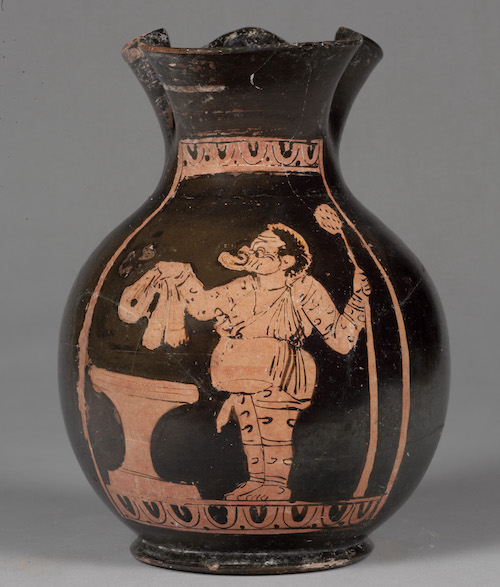Theatre masks in the ancient world
In ancient Greek and Roman theatre, the theatre mask was a tool that allowed actors to assume different characters. They were characterised by large and eccentric features. These allowed audiences of thousands to read the characters' emotions instantly from a distance. This visual hyperbole ensured that the context of the performance was easy to follow, and the different types of characters were easily recognizable.
Masks would have made the characters' faces appear mostly unchanging, so actors probably had to rely heavily on movement and gesture to convey their proposed storyline. Like a mime today, facial expressions needed to be highly recognizable so that the audience could follow their gesture-guided storyline. Some variances in facial expression may have been achieved by different lighting effects, where shadows cast upon the mask made the face distort and change.

Evidence does suggest that theatre masks had different distinct features depending on the character or genre of the play - tragedy, old comedy or new comedy. For example, comedy masks usually feature a large, upturned smile, mischievously furrowed eyebrows, and bizarre face shapes including protruding foreheads. In contrast, tragedy masks feature an anguished downturned mouth, raised eyebrows and wrinkled foreheads. The characters also varied depending on the genre too – slaves are a commonly depicted character in comedy, as well as satyric characters and young men who fall in love.
The masks that real actors wore in antiquity were not like the terracotta examples found in museums today but were made from textiles and organic materials. Scholars speculate that the materials used to make real theatre masks ranged from cloth to cork, wood, and animal hair. Due to the materials not being long lasting, we do not have any examples of a true theatre mask today – the only surviving evidence of theatre masks is representations of them in vase paintings and the terracotta representations we see today in museums. There are also as a few select descriptions from primary sources such as the observations in Julius Pollux’s Onomasticon, and Aristotle’s Poetics.
Some of the ancient clay masks in museum collections are smaller than the average human face, which suggests that not all of these, if any, were intended to be worn. They were too heavy and disorientating for one to properly wear, so it is safe to say that these clay alternatives were not used for theatrical purposes. This begs the question, what were these terracotta copies made for? It is hard to tell with little to no evidence, and scholars have yet to find a definitive answer, but we can make some viable guesses. They may have been used as decoration in one's home or in public places such as the theatre. They may have also been used as votives for Dionysos, the Greek god of theatre. Dionysos was known to have quite a cult following, so it would be possible that one may have left votives such as these at a sanctuary or altar to honor the god. Clay masks may have also been used as funerary offerings for actors – leaving a copy of their character’s mask on the grave may have been a way of honoring their profession in death, much like the Greek custom of leaving the armor or weapons of a soldier in their grave.
